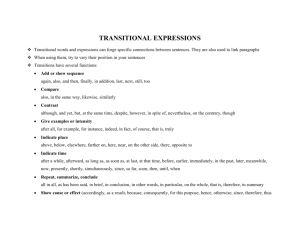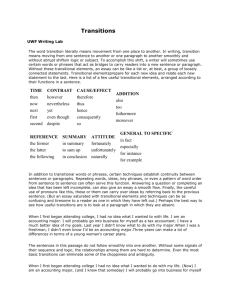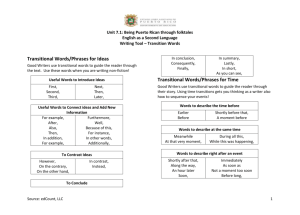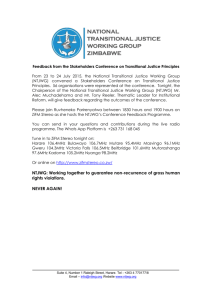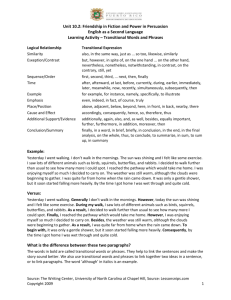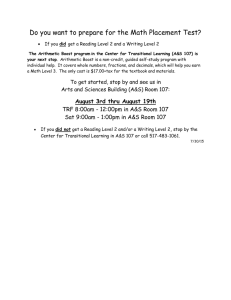15 min.
advertisement
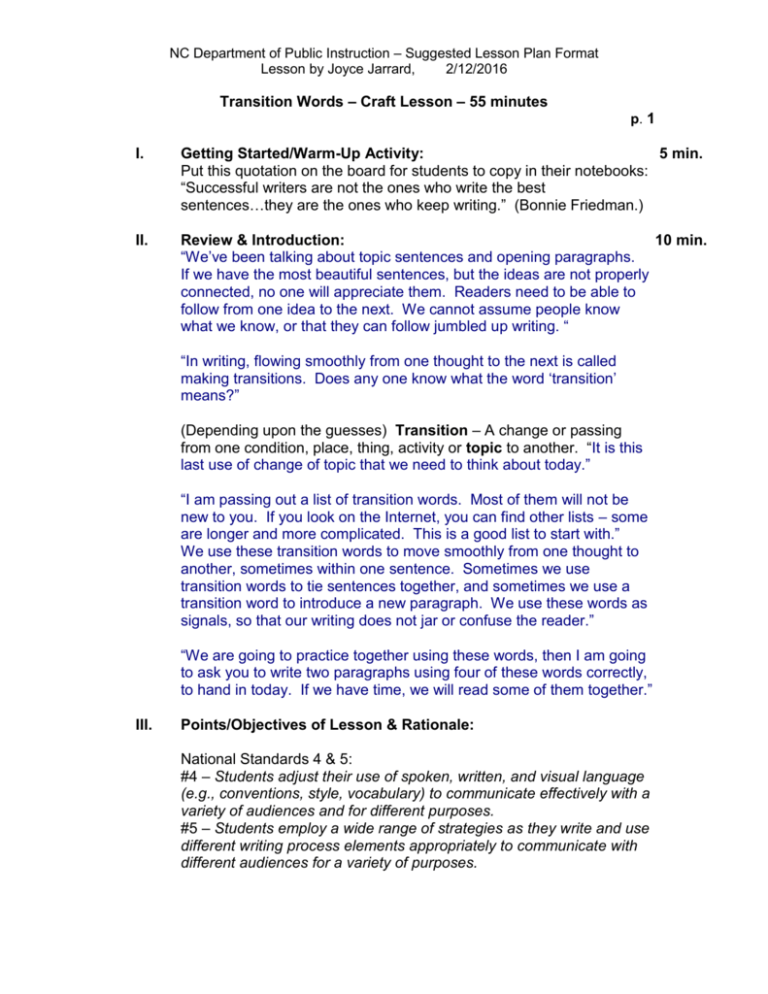
NC Department of Public Instruction – Suggested Lesson Plan Format Lesson by Joyce Jarrard, 2/12/2016 Transition Words – Craft Lesson – 55 minutes p. 1 I. Getting Started/Warm-Up Activity: 5 min. Put this quotation on the board for students to copy in their notebooks: “Successful writers are not the ones who write the best sentences…they are the ones who keep writing.” (Bonnie Friedman.) II. Review & Introduction: 10 min. “We’ve been talking about topic sentences and opening paragraphs. If we have the most beautiful sentences, but the ideas are not properly connected, no one will appreciate them. Readers need to be able to follow from one idea to the next. We cannot assume people know what we know, or that they can follow jumbled up writing. “ “In writing, flowing smoothly from one thought to the next is called making transitions. Does any one know what the word ‘transition’ means?” (Depending upon the guesses) Transition – A change or passing from one condition, place, thing, activity or topic to another. “It is this last use of change of topic that we need to think about today.” “I am passing out a list of transition words. Most of them will not be new to you. If you look on the Internet, you can find other lists – some are longer and more complicated. This is a good list to start with.” We use these transition words to move smoothly from one thought to another, sometimes within one sentence. Sometimes we use transition words to tie sentences together, and sometimes we use a transition word to introduce a new paragraph. We use these words as signals, so that our writing does not jar or confuse the reader.” “We are going to practice together using these words, then I am going to ask you to write two paragraphs using four of these words correctly, to hand in today. If we have time, we will read some of them together.” III. Points/Objectives of Lesson & Rationale: National Standards 4 & 5: #4 – Students adjust their use of spoken, written, and visual language (e.g., conventions, style, vocabulary) to communicate effectively with a variety of audiences and for different purposes. #5 – Students employ a wide range of strategies as they write and use different writing process elements appropriately to communicate with different audiences for a variety of purposes. NC Department of Public Instruction – Suggested Lesson Plan Format Lesson by Joyce Jarrard, 2/12/2016 Transition Words – Craft Lesson – 55 minutes p. 2 NC Competency goal 6: The learner will apply conventions of grammar and language usage. NC Objective 6.1: Model an understanding of conventional written and spoken expression by: using a variety of sentences correctly, punctuating them properly, and avoiding fragments and run on sentences. Students will learn and use some transitional phrases correctly to add clarity, variety, and logical flow to their writing. Middle grade students are capable of incorporating new ideas into their writing, but many of them need to be told specifically what their writing lacks. IV. Materials Needed: Purdue Owl handout on Transitional Devices (Connecting Words) available at http://wl.english.purdue.edu/handouts/print/general/gl_transition.html. There are many similar lists available on the Internet. Transparencies made up with sample sentences for guided practice, (see below.) Students need paper, pens, and writing notebook. V. Guided Practice (teacher/student): “There are many different types of transitions in writing; so today we will only talk about ‘transitional phrases.’ We can think of these as ‘connecting words’, but they are not exactly the same as conjunctions. (Remember, conjunctions are words like “and, but, or, nor” that we use within one sentence to join words together. Remember the Sesame Street jingle, ‘Conjunction junction, what’s your function?’” “Can anyone guess what the connecting word is in this sentence?” Hercules Hogan was huge, muscular, and athletic; therefore, he was confident he would make the football team. “Therefore” is the transitional word. Often we use a transitional word to start a new thought, sentence or paragraph, instead of using the transitional word within one sentence.” “How would I improve these sentences to include a better transition?” I get thirsty and hot in class all day with nothing to drink. We should be allowed to drink sodas in class. I know the custodian wouldn’t want to mop up spills every night. We’re not babies; we could 15 min. NC Department of Public Instruction – Suggested Lesson Plan Format Lesson by Joyce Jarrard, 2/12/2016 Transition Words – Craft Lesson – 55 minutes p. 3 clean up if an accident happened. I think we would do better work if we could have some caffeine in the morning. Teacher reads aloud, pausing after each sentence, asking, “Can you think of a transition word that belongs here?” . Above paragraph with possible transitional words added: I get thirsty and hot in class all day with nothing to drink. Therefore, I believe we should be allowed to drink sodas in class. However, I know the custodian wouldn’t want to mop up spills every night. In fact, we’re not babies, we could clean up if an accident happened. Furthermore, I think we would do better work if we could have some caffeine in the morning! “In each transitional spot, there are several different words that would have worked. You need to choose words that feel natural and have the tone you desire in that particular piece of writing.” VI. Independent Practice: 20 min. “Now, please write (in class) two short paragraphs giving an opinion about any issue you choose. (You can pick an issue like the school dress code, amount of homework you receive, chewing gum or eating in class, or your family’s rules regarding bedtime, or curfew.) In these two paragraphs, you must correctly use at least four transitional words from the handout. “ If time permits, students should trade with a neighbor to share their choice of transitional words, and why they picked those words. VI. Assessment The teacher collects the paragraphs to determine if the students now understand the appropriate use of transitional words. VII. Closure/Expectations: 3 min. “Put this handout in your writing notebook, and keep it for future reference. I want to see you try out different transitional words in your future writings. If you like, there are other more detailed lists available, just ask me.” (If time remains, teacher can read from student paragraphs, with their permission.) Based upon paragraphs written in class, the teacher should determine if the students understand how to use these transition words. If many 2 min. NC Department of Public Instruction – Suggested Lesson Plan Format Lesson by Joyce Jarrard, 2/12/2016 Transition Words – Craft Lesson – 55 minutes p. 4 do not understand, she should do a read-aloud of a text that uses many of these words, and point out the appropriate use of transition words. After a second assessment of transition use, the teacher should conference with those students who are still having difficulty with this concept. She might ask them to highlight these words in the next paperback book they read. Teachers and students can find additional transition word websites at: http://www.uark.edu/campus-resources/qwrtcntr/resources/handouts/transitions.htm http://webster.commnet.edu/grammar/transitions.htm

